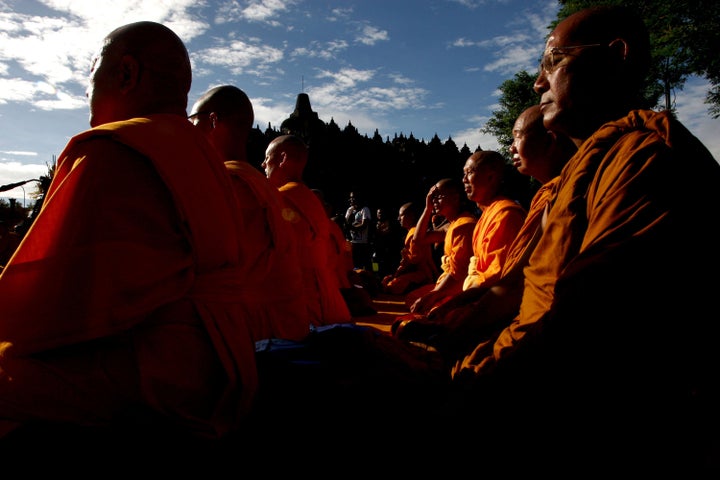
Eyes open or closed? Focusing on an object or your breathing? Repeating a word or mantra?
Different traditions advocate different methods. Transcendental Meditation suggests 20 minutes of meditating with a mantra in the morning and 20 minutes in the evening. I'm familiar with one Buddhist teacher who suggests open-eye meditation. Mindfulness meditation recommends 30 minutes a day focusing on thoughts and feelings. The studies I sited in "Meditation: The New Elixir for All Our Mental Ailments?" used several different techniques. From the studies' reports, each method was effective in obtaining measurable outcomes.
The list of different methods is long. However, they all have one thing is common: The focus is inward. So how do you decide what's the best for you?
The question is, "Why are you meditating?" We each have different reasons, and those reasons can change daily. I distinguish between body-focused and mind-focused techniques. When we are feeling uptight physically, in pain or emotionally overwrought, I've found the body-focused techniques are particularly helpful. These include:
- Focusing on the breath as you inhale and as you exhale.
Here's a guided meditation, "Finding Your Edge," suited for helping the body relax.
Sit in your most comfortable meditation posture and close your eyes. Put one hand over your chest and the other over your belly. As you breathe normally, notice where your muscles contract to begin the breath. Is it in the upper chest, the middle of your belly? If it's in your chest, put both hands there, side by side. If in your belly, put both hands there. Now get a closer sense of where your breath originates. Continue to breathe normally and, without any judgment, simply observe. In your mind, draw a line that represents the start of your breath. This is your edge.
Breathing normally, sense your edge. You can drop your hands if you wish. There's no need to change anything; simply be with your breath. As you relax more, notice what happens to your edge. Stay in the observer mode. Let go and allow yourself to go deeper. At some point if you lose awareness of your breathing, that's fine. Just let go. If thoughts come in and disrupt your meditation, go back to noticing the rhythm of your breathing. Focus inward, relax and breathe.
Allow your edge to dissolve, to drop deeper. Feel your muscles soften and your breath deepen. Meditate on this expanded feeling.
When our minds are racing sometimes the body-focused methods help detract from our thoughts, sometimes not. When they don't, I suggest mind-focused methods:
- Watch your thoughts. Simply observe what you are thinking and how you are thinking.
These techniques can calm the mind and help you settle into your meditation. Another aid is to simply give the mind something to do. Here's a guided meditation, "Notice what you notice," for quieting the mind.
As you sit in your favorite quiet spot, begin by being aware of your surroundings. Take in the colors and textures, the sounds and smells. A squirrel scratching at the earth to dig up a nut. The dusty odor of the furnace coming on. A soft warmth on your cheek from the sunlight filtering in through the blinds. Whatever you notice, just catalog it in your mind as something interesting. Don't do anything. In fact, resist the temptation to swipe at the cobweb or adjust the thermostat.
With each new sensation, notice where your thoughts go. Maybe you remember something painful. If so, then notice the pain. Where is it located in your body? What stories does your mind start telling you? Be curious about the pain, as if it is the first time you've experienced it.
Whether the dusty odor of the furnace makes you want to change the air filter, or you associate it with a visit at nasty Aunt Beulah's, the key is to be inquisitive about what you notice and not judgmental. Judgment is what takes us out of the present moment and squelches our relaxation. So allow the mind to roam freely. Just keep noticing where it goes and what impact it has on your body and your emotional state.
Be a pioneer within yourself. Each thought is new. Each sense experience is new. Each breath is as new as the infant's first breath. Enjoy the wonder and meditate.
As our mind relaxes, our body relaxes, and vice versa: As our body relaxes, our mind relaxes. So, in this sense, whatever you do will help. I've also found that while I'm meditating I get ideas that help me meditate more deeply. (Breath to brain technique sited above is an example.) You may also find that your meditations produce suggestions that are perfect for you.
For more than 20 years, Susan Morales, M.S.W. has explored human behavior through her work as a psychotherapist, and as a student/practitioner of meditation. In addition to using meditation as a device to help clients with issues of anxiety and depression, she offers classes and retreats to women in substance abuse recovery. She developed Be Who You Love Meditation as a method to teach people how to find greater depth of satisfaction in their lives. She blogs on meditation for annarbor.com and Red Room, and was on the editorial board for The Voice of Social Workers: Poets and Writers, a journal recently published by the Michigan chapter of NASW.